TOPIC: A STUDY ON THE IMPACT OF SOCIAL MEDIA DURING COVID PANDEMIC SITUATION AMONG STUDENTS
Introduction
1. Introduction
The emergence of the COVID-19 outbreak has given rise to adverse events and nationwide lockdowns. It has restricted social activities, and people’s movement as the government has advised citizens to stay at home. In India, all educational institutes shifted to online classes to maintain social distancing regulations. During this time, rapid growth of social media usage among students has been observed. As the students were unable to interact with their peers and teachers directly, they were increasingly utilising social platforms to communicate. The introduction provides an overall background, rationale and significance of the research, which will highlight the research area and its importance.
2. Background
The unprecedented growth of the COVID-19 outbreak has resulted in nationwide lockdowns and social distancing regulations. The Indian government announced the closure of all educational institutes to maintain the social distancing norms. The “Ministry of Human Resource Development” shared various “e-learning platforms” in their press releases to support the decision of government (Haddad et al. 2021). Platforms such as “Study Web for Active Young Expiring Minds (SWAYAM)”, “SWAYAM Prabha”, “National Repository of Open Educational”, “e-Pathshala”, “DIKSHA porta”, and “National Programme on Technology Enhanced Learning” have been highlighted to enable the students to learn during the lockdown. The Indian government has decided to continue the academic courses in online mode and requested that teachers conduct classes online.

Figure 1: Impact of COVID-19 on media consumption
(Source: Statista, 2023)
The “higher education institutions (HEIs)” concentrated on using technology to support distance education, remote learning and online learning during the pandemic. Simultaneously, the use of social media has increased among students in addition to open-source platforms such as “WhatsApp”, “Google Hangout”, “Skype” and “YouTube” to deliver online teaching sessions (Dutta, 2020). During the COVID-19 pandemic, the use of social media has increased by around 75% in the country. People were spending more time on the Internet and various digital platforms and consumption of radio and “out-of-home billboards” has dropped significantly. The online learning strategy has increased the dependency of students and teachers on social media apps to maintain smooth communication.
Due to the regular use of social networking platforms, students started using social networking sites for communicating with friends and it became a part of their daily routine. Currently, India has crossed 900 million internet user’s majority of which are users of social platforms like “Facebook”, “Twitter” and “Instagram”. On the other hand, cost of the Internet packs become significantly cheaper in the country, which has influenced the increased use of the Internet among students (Luo, 2021). Social networking platforms have helped in reducing loneliness and anxiety among students; however, it has also created adverse effects on individuals. It has been observed that students spend more and more time on social networking sites, which has disrupted their sleeping patterns. The increased use of social media has created a negative effect on education as students are more attracted to surfing the internet than concentrating on their classes.
3. Rationale
One of the major issues of social media usage by students is the lack of concentration on their studies. The students were more interested in visiting their “Facebook” and “Instagram” pages than focusing on their online classes. As a result, it created a gap in their education and limited the learning objectives of the online classes. On the other hand, students became addicted to social media as it has provided them with opportunities to interact with their peers and friends, without going out of their houses (Hudimova et al. 2021). “Facebook” has been integrated with various games, which can be played online, and has attracted individuals to spend increased time on social media platforms. During the lockdown, it has provided a platform to interact with other people and it has emerged as one of the largest platforms of entertainment.
Hence, the sleeping pattern of the students has been affected as they have been spending a high amount of time on the internet. In the aftermath of the pandemic, the use of social media is still rapidly growing among people. “Facebook” has the highest number of users in India highlighting the continuous growth of social networking platforms. Due to the increased exposure to the celebrity lifestyle, students in their teenage years are exposed to unrealistic views about lives resulting in decreasing satisfaction in their own life (Radwan et al. 2020). As a result, it has been facilitating depression among students due to a lack of satisfaction and exposure to bullying and harassment.
4. Research Significance
The study on the effect of social media on students during the COVID-19 pandemic has analysed the advantages and drawbacks. It can highlight the effectiveness of social media in maintaining positive interaction among individuals, which is effective in reducing the scope of anxiety and depression during lockdown situations. On the other hand, long-term exposure to social media has created negative effects on students as they have been experiencing a lack of concentration and willingness to focus on their classes (Kaya, 2020). The research can highlight the importance for students to understand the adverse impact of excessive use of social media. Additionally, it can provide parents with a comprehensive view of how social media is affecting the viewpoints of individuals.
5. Summary
The study has highlighted the background of the research topic, which elaborated on the pandemic situation in India. The background has informed the reason behind the online learning session and how it has affected the learning capability of the students. The rationale depicted the challenges and their impact on the students and significantly informed the importance of the research.
Aims/objectives of the research followed by research questions
1. Research aim
The aim of the paper is to evaluate the effect of social media on students during the COVID-19 pandemic through a detailed analysis of the benefits and the disadvantages of social media platforms. The research focuses on highlighting the reason behind the facilitation of using social networking sites among students in India. The research also aims to indicate the use of social networking sites in conducting online classes during the lockdown and their contribution to the education system. Later, the study aims to analyse the overall impact of social media on students and inform its positive and adverse impacts on individuals. It will help in assessing the affirmative sides of social media, which provides the students with a platform to connect with their teachers, which increases the effectiveness of the online classes. On the other hand, it will also discuss the negative impact of social media, which has decreased concentration and willingness to learn from online classes. As last, the paper also aims to provide a few mitigation strategies for reducing the negative effect of social media on students.
2. Research Objectives
- To analyse various social networking platforms to observe their popularity among students
- To identify the application of social media sites in educational institutions during the pandemic
- To assess the impact of social media on students during the COVID-19 pandemic
- To identify the challenges of excessive social media usage among students
- To provide adequate recommendations to reduce the adverse effects of social media
3. Research questions
- How do social networking sites become popular among students during COVID-19?
- What are the positive and negative effects of social media on the students?
- How can the negative impact of social networking sites on students be reduced?
Brief Literature Review
1. Introduction
The COVID-19 pandemic has increased the use of social networking sites in India, especially during the initial phase of the lockdown. The average use of “social networking sites” was “3 hours and 37 minutes” on June 2020. The literature review aims to analyse the information collected from online sources to meet the research objectives and questions. The chapter has been also integrated with the conceptual framework and the application of theory. The literature gap has also been informed in this chapter as well.
2. Concepts
2.1. Analysis of various social networking sites and their popularity among students in India
According to Ngien and Jiang (2022), “Facebook” is one of the most used platforms among Indian students. Facebook has gained popularity among students due to its features of sharing photos, videos and testing options, which enables individuals to connect with other people. Asghar et al. (2021) state that social networking sites have become a source of entertainment during the pandemic as they provide a platform for communication and sharing media with their friends. Moreover, social networking platforms have provided students with the opportunity to constantly stay in touch with their friends, which has been facilitated by the lower cost of internet packages in India.

Figure 2: Facebook usage in India
(Source: Statista, 2023)
2.2. Application of social media for educational purposes during the lockdown period
WhatsApp has been the most used platform for conducting online classes as it supports group audio and video classes. According to Papademetriou et al. (20222), the educational sector has been using social platforms to conduct online classes as they provide better each to the students. On the other hand, the easy access and user interface have increased the popularity of WhatsApp for conducting digital learning sessions. Abbas et al. (2021) opined that Zoom, Google Meet and “Microsoft Team” have also been popular among educational institutes as they provide group call features.
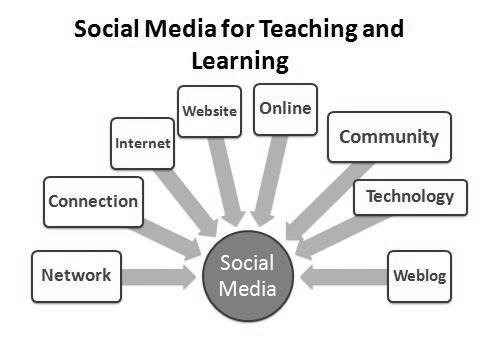
Figure 3: Use of social media in education
(Source: Abbas et al. 2021)
2.3. Effect of social media on the Students during the COVID-19 Lockdown in India
Due to the increased use of social media platforms, students had regular access to the internet. As per Marzouki et al. (2021), online classes have influenced the affinity towards social media platforms among students. In the initial stages, students used social sites to communicate with their teachers to solve their issues. However, Mourad et al. (2020) stated that the students were interacting with their peers through social platforms as they met them during the lockdown. Gradually, the students become addicted to social media, which has decreased concentration in their lessons and interrupted their sleeping patterns. It has resulted in a negative impact on the mental health of the students, which has affected their academic performance.

Figure 4: Impact of COVID-19 and social media on students
(Source: Mourad et al. 2020)
2.4. Assessment of various challenges of social media among students in India
One of the crucial challenges of social media usage is the unrealistic view of the students regarding their lives. Tkáčová et al. (2021) opined that social media paints an illogical view of real life, which can result in dissatisfaction among students. It has led to depression and anxiety, which has affected the mental health of the students. As per the understanding of Wheaton et al. (2021), excessive use of social media has reduced the level of concentration among students. The students have been more interested in chatting with their friends and sharing posts rather than concentrating on online classes. It has reduced the academic performance of the learners during the lockdown and induced their affinity towards online gaming and interaction on social networking platforms.

Figure 5: Challenges of Social Media on Students
(Source: Wheaton et al. 2021)
2.5. Recommendation for eradicating the issues of social media usage among students
Parents can play a vital role in reducing the adverse impact of the internet on learners. According to Gómez-Galán et al. (2020), parents need to limit the time of using social networking platforms to decrease their daily usage. It will provide the students with significant time to interact with their friends and complete their studies. It can help in maintaining a strict bedtime routine, which will help in controlling irregular sleeping patterns. According to Cuello-Garcia et al. (2020), interacting with the students regarding their views on social media usage can also help in addressing unrealistic views. It can assist in reducing the scope of depression and anxiety among the students and foster healthy communication.
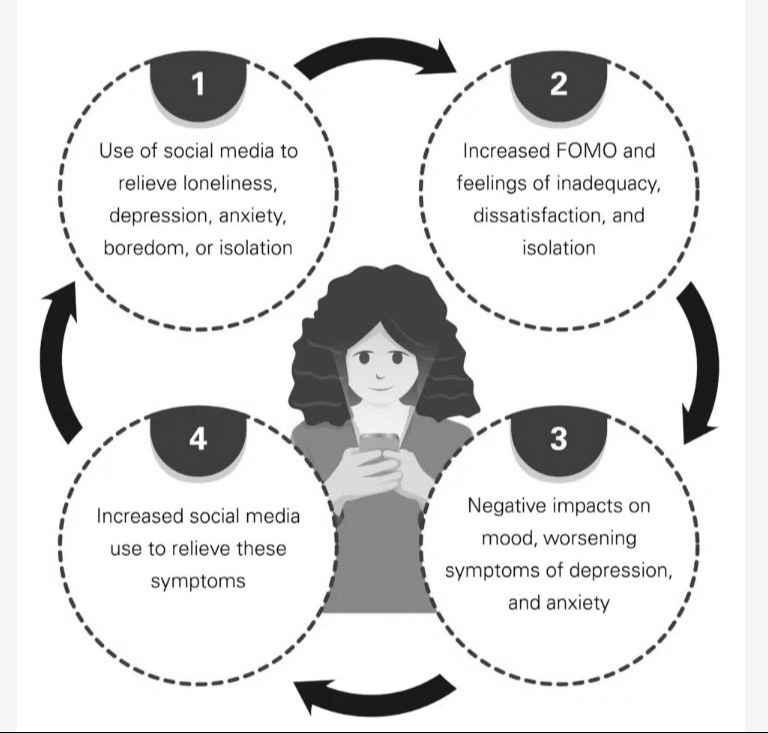
Figure 6: Social media addiction cycle
(Source: Cuello-Garcia et al. (2020)
3. Conceptual framework
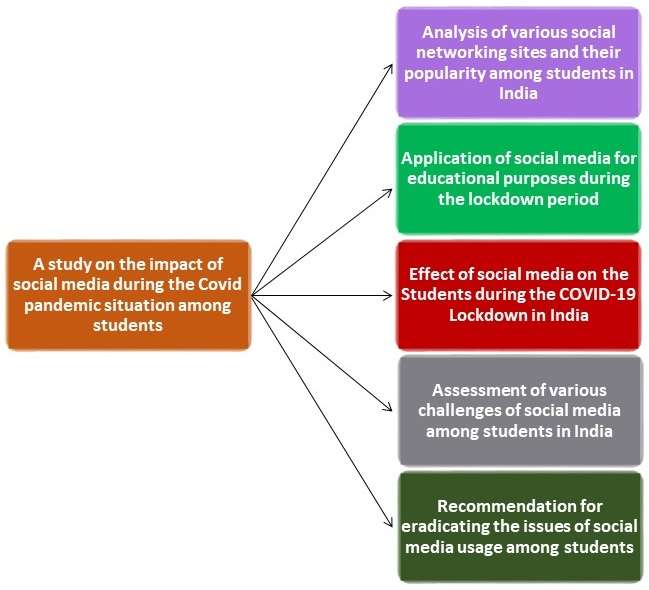
Figure 7: Conceptual framework
(Source: Self-created)
4. Application of Theory
The Medium Theory of McLuhan
According to “McLuhan’s Medium Theory,” there are several ways that a particular message can reach an audience and have varied effects depending on the various platforms. This idea contends that the media constitutes a varied range of contexts and may affect how information is shared in different ways. The medium perspective reverses a message’s actual meaning to make it easier to interpret from various angles. Applying the principle, people can spread pertinent information to reduce the adverse impact of social media by highlighting its negative impact. According to Liu et al. (2021), the medium theory can aid in comprehending social platforms, which can further aid in understanding data dissemination. It can also help the students in identifying the adverse impacts of the excessive use of the Internet.
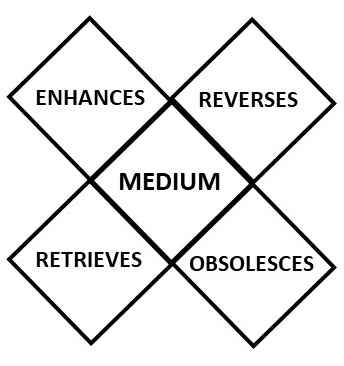
Figure 8: McLuhan’s Medium Theory
(Source: Liu et al. 2021)
5. Literature gap
The chapter has analysed various aspects of social media usage among students during the pandemic in India. However, It has not analysed the impact of technological advancement and the Digital Divide, which has brought irregularities in social media usage among students. Hence, it has created a significant gap in the literature.
6. Conclusion
The study has shed light on the various aspects of using social media during COVID-19 in India. Due to the social networking site’s ability to facilitate communication and the exchange of media with friends, they have developed into a source of enjoyment throughout the pandemic. Because it offers pupils a better experience, educational institutions have started adopting social media to conduct online classes. Students’ inclination for social networking platforms has been affected by their online lessons. Instead of focusing on their online lessons, learners have been more engaged in conversing with their peers and sharing messages. In order to reduce their daily usage, parents must set time limits for their children to use social networking sites.
Methodology
1. Introduction
Methodology highlights the process of assessing a particular event to determine the procedure of data collection and assessment. It helps in gathering information to provide adequate answers to the research question. This chapter will highlight the proposed research method for the research on the impact of “social media” during the COVID-19 pandemic on students in India. It includes philosophy, design, approach, data collection and assessment along with sampling and research ethics.
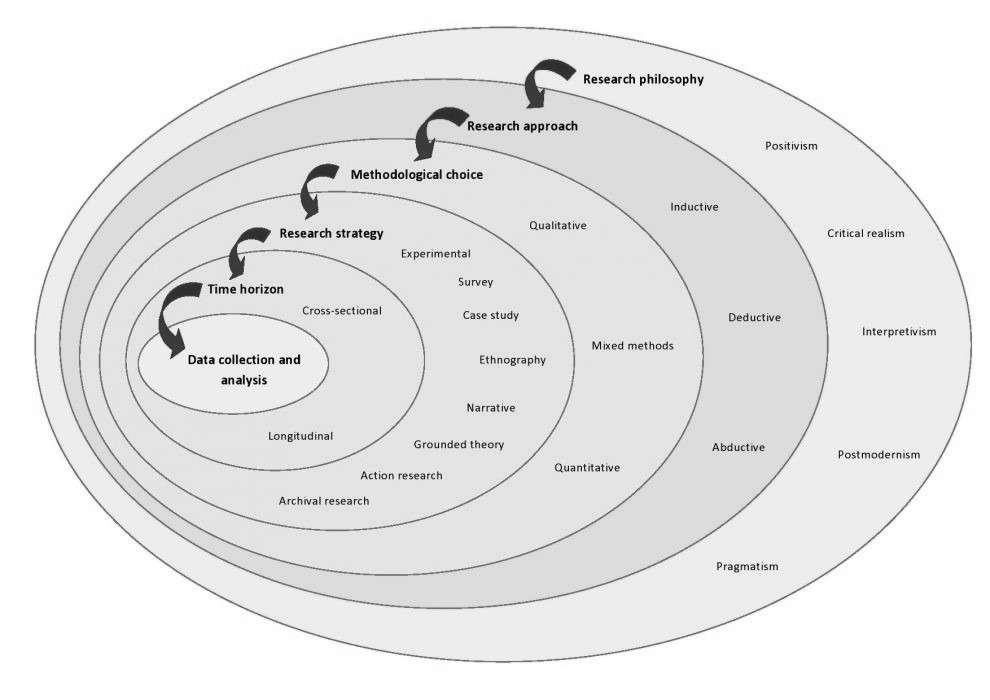
Figure 9: Research onion
(Source: Camacho et al. 2020)
2. Philosophy
Research philosophy is an important part of the research method as it highlights the techniques of data gathering associated with a certain event. There are mainly three kinds of research philosophies, which are positivism, realism and interpretivism. In this research, realism will be used to analyse the information related to the use of “social media” by students during the pandemic (Tsoy et al. 2021). Realism relies on the practical knowledge of an event, which will assist in integrating scientific practices into the research. On the other hand, realism identifies the importance of scientific explanations regarding phenomena. As a result, it will assist in analysing the positive and the adverse impact of “social media” among students.
3. Approach
The research approach is divided into two main groups “inductive” and “deductive”, which determine the data assessment process. The “inductive approach” will be incorporated into the study to analyse the collected data on the use of “social media” among students in India (Jogezai et al. 2021). One of the main advantages of the inductive approach is that it facilitates observations. As a result, it will help in analysing collected data to identify the patterns.
4. Design
Research designs are segmented into various groups, which helps in determining the use of collected data in confirming a particular event and its core reasons. The explanatory design will be used in this study to increase understanding regarding the impact of “social media” on students (Sobaih et al. 2022). It also helps in ascertaining the reason behind a phenomenon and assists in predicting future occurrences. As a result, the explanatory design will help analyse the adverse effect of “social media” on students and its future implications.
5. Data collection
The data collection process is associated with gathering information regarding a particular event. It is generally divided into three groups; “primary”, “secondary” and “mixed”. In this research, a mixed approach will be integrated to gather both primary and secondary data. The “primary data” will be collected through the interview process to acquire information regarding the use of “social media” by students (McGill et al. 2021). The interview will help in collecting qualitative information regarding the research. As a result, “qualitative data collection” helps researchers obtain a variety of data regarding the topic through a variety of “open-ended questions”. Qualitative data aids in removing personal biases from the data that is being collected. It enables scholars to learn everything there is to know about a subject from many angles.
The students and the teachers of various schools will be selected as the participants in the interview process to provide insight regarding the use of “social networking sites” during the pandemic in India (Cleofas, 2022). On the other hand, secondary qualitative data will be collected from the journals, articles and government publications collected from authentic sources such as “ProQuest” and “Google Scholar”. It will assist in building strong oxidation of the study.
6. Data analysis
The primary data, which will be collected in the interview process will be analysed by a thematic coding approach. It will help in analysing the opinions of the interviewees systematically to highlight various themes, which will answer the research questions (Camacho et al. 2020). On the other hand, the “secondary data” will be assessed through thematic analysis to highlight the effects of utilising various “social platforms” on students during the lockdown in India.
7. Sampling techniques
The sampling approach involves choosing a specific group from, which to gather data for the study. “Simple random sampling” will be employed in this study to gather the necessary information about the impact of “social media” use among Indian students. “Simple random sampling” draws attention to the technique of choosing sources for data collection at random. The collection of information was randomly chosen, therefore the research using these samples has a high level of validity both internally and externally (Lê and Schmid, 2022). Applying “random sampling” will be made it easier to incorporate data with minimal researcher bias. It will assist in the selection of pertinent information from web sources to gather proper information about the difficulties faced by the students due to the excessive use of “social networking platforms” during the COVID-19 lockdown.
8. Validity and reliability
The reliability and validity of the research are associated with its integrated data in the study. This research will collect information from authentic sources to maintain the reliability of the provided details regarding “social media” usage among students in India and its impact (Cleofas, 2022). Moreover, personal bias will be avoided to deliver valid outcomes regarding the disadvantage and positive sides of utilising “social media”.
9. Research ethics
The “research ethics” or “ethical considerations” are generally the guidelines, which assist in maintaining transparency. The participants of the interview process will be informed regarding the purpose of the research to get informed consent. The “identifiable information” regarding the participants will be kept confidential to maintain anonymity and confidentiality (Gunasekeran et al. 2022). The collected information from the interview and the “secondary data collection” process will be stored in a “password protected” folder.
10. Summary
The methodology has provided a detailed view of the research process and techniques for collecting information. The research will employ both primary and secondary techniques to collect information regarding the impact of “social media” on students during the pandemic. Conducting interviews and gathering data from the existing sources will help in collecting a wide range of information regarding various “social networking sites” and their popularity among students during the lockdown in India.
Required resources
As the research will employ both primary and secondary processes, it will require significant effort and time to collect relevant information. In the first stage, secondary data will be collected from the online sources. In order to collect the secondary information, the researcher will need to have access to the internet and an adequate desktop or laptop. As the researcher has access to both of these elements, gathering secondary information will be easy. It requires fewer financial resources as access to the internet can help in collecting the majority of the required data (McGill et al. 2021). On the other hand, conducting interviews will require significant time, as “face-to-face” and “telephonic interviews” require time. The interview will be semi-structured and will have a few pre-determined questions and a few spontaneous questions to assess the opinions of the participants.
The pre-determined question will be formed assessing the secondary data to form relevant questions. Permission from various educational organisations will be taken to interview the teachers and the students. The “telephonic interview” will be recorded and the audio will be deleted after the successful submission of the research. As a result, the interview process can extend the collection period significantly and it will require substantial financial resources to acquire recording equipment for the interview process. Additionally, for the “face-to-face” interview, a suitable location and room will be required to conduct the interviews.
References
Abbas, J., Wang, D., Su, Z. and Ziapour, A., 2021. The role of social media in the advent of COVID-19 pandemic: crisis management, mental health challenges and implications. Risk management and healthcare policy, pp.1917-1932.
Asghar, M.Z., Iqbal, A., Seitamaa-Hakkarainen, P. and Barbera, E., 2021. Breaching learners’ social distancing through social media during the COVID-19 pandemic. International journal of environmental research and public health, 18(21), p.11012.
Camacho, D., Panizo-LLedot, Á., Bello-Orgaz, G., Gonzalez-Pardo, A. and Cambria, E., 2020. The four dimensions of social network analysis: An overview of research methods, applications, and software tools. Information Fusion, 63, pp.88-120.
Cleofas, J.V., 2022. Social media disorder during community quarantine: A mixed methods study among rural young college students during the COVID-19 pandemic. Archives of Psychiatric Nursing, 40, pp.97-105.
Cuello-Garcia, C., Pérez-Gaxiola, G. and van Amelsvoort, L., 2020. Social media can have an impact on how we manage and investigate the COVID-19 pandemic. Journal of clinical epidemiology, 127, pp.198-201.
Dutta, A., 2020. Impact of digital social media on Indian higher education: alternative approaches of online learning during COVID-19 pandemic crisis. International journal of scientific and research publications, 10(5), pp.604-611.
Gómez-Galán, J., Martínez-López, J.Á., Lázaro-Pérez, C. and Sarasola Sánchez-Serrano, J.L., 2020. Social networks consumption and addiction in college students during the COVID-19 pandemic: Educational approach to responsible use. Sustainability, 12(18), p.7737.
Gunasekeran, D.V., Chew, A., Chandrasekar, E.K., Rajendram, P., Kandarpa, V., Rajendram, M., Chia, A., Smith, H. and Leong, C.K., 2022. The impact and applications of social media platforms for public health responses before and during the COVID-19 pandemic: systematic literature review. Journal of Medical Internet Research, 24(4), p.e33680.
Haddad, J.M., Macenski, C., Mosier-Mills, A., Hibara, A., Kester, K., Schneider, M., Conrad, R.C. and Liu, C.H., 2021. The impact of social media on college mental health during the COVID-19 pandemic: a multinational review of the existing literature. Current psychiatry reports, 23, pp.1-12.
Hudimova, A., Popovych, I., Baidyk, V., Buriak, O. and Kechyk, O., 2021. The impact of social media on young web users’ psychological well-being during the COVID-19 pandemic progression. Revista Amazonia Investiga, 10(39), pp.50-61.
Jogezai, N.A., Baloch, F.A., Jaffar, M., Shah, T., Khilji, G.K. and Bashir, S., 2021. Teachers’ attitudes towards social media (SM) use in online learning amid the COVID-19 pandemic: the effects of SM use by teachers and religious scholars during physical distancing. Heliyon, 7(4), p.e06781.
Kaya, T., 2020. The changes in the effects of social media use of Cypriots due to COVID-19 pandemic. Technology in society, 63, p.101380.
Lê, J.K. and Schmid, T., 2022. The practice of innovating research methods. Organizational Research Methods, 25(2), pp.308-336.
Liu, H., Liu, W., Yoganathan, V. and Osburg, V.S., 2021. COVID-19 information overload and generation Z’s social media discontinuance intention during the pandemic lockdown. Technological Forecasting and Social Change, 166, p.120600.
Luo, C., 2021. Analyzing the impact of social networks and social behavior on electronic business during COVID-19 pandemic. Information Processing & Management, 58(5), p.102667.
Marzouki, Y., Aldossari, F.S. and Veltri, G.A., 2021. Understanding the buffering effect of social media use on anxiety during the COVID-19 pandemic lockdown. Humanities and Social Sciences Communications, 8(1).
McGill, E., Er, V., Penney, T., Egan, M., White, M., Meier, P., Whitehead, M., Lock, K., de Cuevas, R.A., Smith, R. and Savona, N., 2021. Evaluation of public health interventions from a complex systems perspective: a research methods review. Social Science & Medicine, 272, p.113697.
Mourad, A., Srour, A., Harmanani, H., Jenainati, C. and Arafeh, M., 2020. Critical impact of social networks infodemic on defeating coronavirus COVID-19 pandemic: Twitter-based study and research directions. IEEE Transactions on Network and Service Management, 17(4), pp.2145-2155.
Ngien, A. and Jiang, S., 2022. The effect of social media on stress among young adults during COVID-19 pandemic: Taking into account fatalism and social media exhaustion. Health Communication, 37(10), pp.1337-1344.
Papademetriou, C., Anastasiadou, S., Konteos, G. and Papalexandris, S., 2022. COVID-19 pandemic: the impact of the social media technology on higher education. Education Sciences, 12(4), p.261.
Radwan, E., Radwan, A. and Radwan, W., 2020. The role of social media in spreading panic among primary and secondary school students during the COVID-19 pandemic: An online questionnaire study from the Gaza Strip, Palestine. Heliyon, 6(12), p.e05807.
Sobaih, A.E.E., Palla, I.A. and Baquee, A., 2022. Social media use in e-learning amid COVID 19 pandemic: Indian students’ perspective. International Journal of Environmental Research and Public Health, 19(9), p.5380.
Statista, 2023. Impact of the coronavirus (COVID-19) on media consumption in India as of March 2020, by type of media. [Online]. Available at: https://www.statista.com/statistics/1113485/india-coronavirus-impact-on-media-consumption-by-media-type/ [Accessed on 26-04-2023]
Statista, 2023. Leading countries based on Facebook audience size as of January 2023. [Online]. Available at: https://www.statista.com/statistics/1113485/india-coronavirus-impact-on-media-consumption-by-media-type/ [Accessed on 26-04-2023]
Tkáčová, H., Pavlíková, M., Jenisová, Z., Maturkanič, P. and Králik, R., 2021. Social media and students’ wellbeing: An empirical analysis during the covid-19 pandemic. Sustainability, 13(18), p.10442.
Tsoy, D., Tirasawasdichai, T. and Kurpayanidi, K.I., 2021. Role of social media in shaping public risk perception during COVID-19 pandemic: A theoretical review. International Journal of Management Science and Business Administration, 7(2), pp.35-41.
Wheaton, M.G., Prikhidko, A. and Messner, G.R., 2021. Is fear of COVID-19 contagious? The effects of emotion contagion and social media use on anxiety in response to the coronavirus pandemic. Frontiers in psychology, 11, p.567379.
